Questionnaires were sent out to a total of 440 institutions, and a total of 271 institutions replied. In terms of percentage, 61.6% of the institutions replied. The following is the result of the survey questions.
A. Situation of the Collections
We asked whether the institution held any original language materials related to the Islamic area regardless of whether the materials were open or closed to the public, and catalogued or not.

There were 10 institutions which replied as "held in other
department(s)", but out of those 10 institutions, four replied that
materials were held in other department(s) as well as their own
institution. So, in this section, "held only in other department(s)
were tabulated and mentioned here.
The figure in italics indicate the percentage of the total
questionnaires mailed. Even if the institutions which did not reply
are tabulated as non-holders, approximately 20% of the institutions
have materials related to Islamic area studies. Perhaps due to the
extensive research of those institutions definitely holding
materials, it still seemed the percentage of institutions holding
materials were unexpectedly higher than we had initially
anticipated.
As to those institutions which replied as "others", we received
answers such as "absolutely no idea" and "yes we have related
materials", but they were not necessarily materials written in the
original languages by the people in the Islamic area.
B. Possibilities of future collections
To those institutions which replied "no" in section A, we asked whether they had any plans of possibly collecting materials in the future.

More than half of the institutions are willing to consider starting a collection of materials if there is a demand, while there were university libraries which replied "definitely no" although they have related lecture courses in their academic curriculum. Of those which replied "if requirements are met", the requirements or conditions are if the materials can be conveniently collected, if staff with knowledge of various languages can be procured, or when the environment to manage the materials mechanically can be achieved.
There is one additional response in this section due to the inclusion of the institution that replied "others" in section A.
C. Why the Collection Was Started (check all applicable answers)
We asked those institutions which replied "yes" to possessing a collection the reason why collection was started.
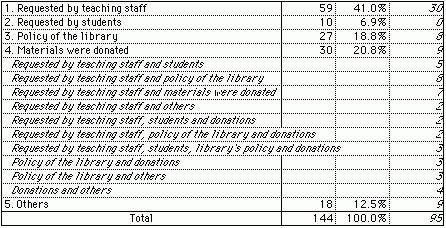
Those multiple answers are indicated in italic characters, while figures in italics are those of single answers. Considering the multiple answers, those replied as "requested by teaching staff" outnumber the rest. Of those which replied as "policy of the library", half of those were research institutions affiliated to universities and specialized research institutions.
Those institutions which replied "materials were donated" held large collections, while those that replied as "requested by teaching staff" and "policy of the library" simultaneously, and those institution which answered merely as "materials were donated", were the ones with smaller collections. These are the two trends we found.
Those institutions that replied as "others", held collection which began when new departments were established, and/or those materials included in the recently purchased new series.
D. Types and Volume of the Material
To those institutions which replied as possessing a collection, we further inquired the type and volume of the material. Listed below are total volumes (total, approximate) collected according to the different types of material.
Books (volume, title) Periodicals (title)
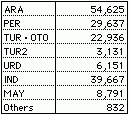
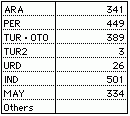
Microfilm (reel, case) Manuscripts (number)
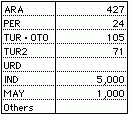
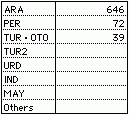
These numbers are merely approximate figures. Depending on the institution, there were distinctive differences in what materials are considered as vernacular materials (for instance are dictionaries and grammar texts included), or the units used in tabulating the volumes. Moreover, detailed figures could not be obtained since the inquires were requested during the middle of the fiscal year. Therefore, in this section, the replies stating the figure of titles were interpreted as volumes, and it's safe to consider those as the minimum figures. The institutions which did not indicate detailed volume figures are given in total figures, so the total should be more than the figures indicated here.
Very few institutions possessed source materials such as microfilms and manuscripts, and the results indicate that majority of the such collections were held by a few specific institutions.
The other source materials indicated in these tables are maps and CD-ROMs.
The table below indicates the number of institutions according to the size of their collection of books, which is the largest group of source materials.
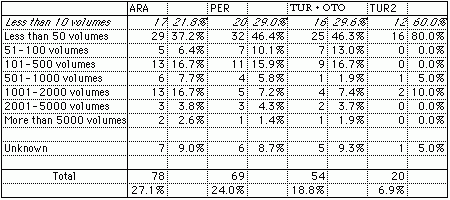
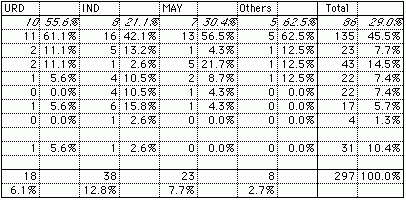
Of the institutions with source materials, approximately half of them possess a small collection of less than 50 volumes (half of those have a collection of less than 10 volumes). This trend is seen regardless of the differences in language.
In terms of language differences, Arabic and Persian materials are most commonly found in institutions. As a result of this survey, we are now able to grasp the previously unknown volumes of original materials written in the original languages by people in the Islamic area possessed by the various institutions.
We made further inquires on cataloguing procedures to those institutions which replied as possessing a collection.

There were multiple answers according to different languages which is the reason as to why the total numbers exceeds 100. The most common reply was that a "portion of the collection" had been catalogued, in which either half or two thirds of the collection has been already catalogued. But as to the institutions with newly established departments and those with related lecture courses, only about 10% replied as their collection being arranged or catalogued.
We anticipated that cataloguing process would be sluggish due to character problems, and partially to stockpiling, but the results indicate approximately 80% of the institutions have already done some cataloguing of their collections.
Some institutions replied that a "catalogue draft or simplified list of materials" have been completed, which are generally institutions that purchased a large collection at once. Of the institutions which replied "none so far", half of them are small collections and the other half are those with some possessions.
F. Reasons Why the Collections Are Not Catalogued
Further inquiry was made to those institutions which answered
"none so far", or that a "catalogue draft, simplified list of
materials" has been completed, in terms of why the collection is yet
to be catalogued.
The major obstacles lies in language and personnel as in
"difficulties with language (character) and procuring personnel"
knowledgeable in this field, and access to computer facilities as
seen in difficulties in processing "specialized characters".
Furthermore, some institutions replied as having the staff but lack of "time, and financial difficulties", as the reason to why the collections are not completely catalogued.
G. Methods of Arrangement and Catalogue
a. Arrangement methods
We asked what methods are used in arranging the materials to those institutions which replied that "most of the collection", and "portion of the collection" has been catalogued.
a-1. Characters

At university libraries transliteration has been used the most. Moreover, at libraries with small collections, measures such as using parallel title in Western language or Japanese for arrangement exemplifies the hardship in the cataloguing process of materials.
Research institutions affiliated to universities and specialized institutions, in many cases, catalogue their materials according to the original language. There were some institutions which catalogued materials in different characters for description and heading.
As for modern Turkish and Indonesian which uses the Roman alphabet, original languages are used for cataloguing, therefore the percentage further increases for Arabic source materials using the transliteration system. The primary systems of transliteration are LC (Library of Congress) and NCR (Nippon Catalogue Regulations), but there were numerous institutions which only replied "by romanization and alphabetization", without designating its transliteration system. Thus we can see that transliteration systems vary.
a-2. Cataloguing regulations

Nearly three-fourths of the institutions either used or relied on the AACR2 (Anglo-American Cataloguing Rules, 2nd Edition) format to catalogue their materials. Moreover, there are institutions which used their own format to catalogue the materials. Whether using a standard format or an original method are basically dependent on the arrangement and cataloguing policies of the library, which handle the materials as western publication, rather than the problem of original language materials of the Islamic area.
a-3. Classification

Although there are differences in the editions, NDC (Nippon Decimal Classification) system is used by most institutions. For numerous research institutions affiliated to universities and specialized institutions, it seems classification regulations already in use are not detailed enough, thus they use original classification methods useful for research.
a-4. The Stacks


The method in presenting this question was not proper, which in turn resulted in insufficient replies. Whether the institution used an open stack/closed stack system had nothing to do with language differences, but rather depends more or less on subject matters and user's demand, as well as being swayed by the library facility and reading room policies.
Concerning how the materials are classified or allotted, most university libraries have arranged the original materials related to the Islamic area with the Western materials, while research institutions affiliated to universities and specialized institutions with large collections seemed to arrange their materials according to different languages.
a-5. Cataloguing Staff

The overall process of cataloguing of materials in most cases are conducted by the library staff, but most transliteration are done by research departments, teaching staff, and part-time staff with related specialization.
a-6. Cataloguing of Original Language Materials of the Islamic Area
The survey asked institutions to respond freely on the cataloguing circumstances of original language materials of the Islamic area. We received many responses which respective institutions "could not procure staff who had knowledge of original languages", so the "cataloguing process was slow", or "we asked teaching staff in related departments or students to handle the transliteration, or had them done through the assistance of outside employees".
Also, there were many institutions which used the "data obtained
from NACSIS and Library of Congress MARC" and "used Western parallel
titles" in cataloguing their materials.
At institutions where original language was used for cataloguing,
attempts with computers were made to illustrate the characters.
b. Catalogue
To those institutions which replied that their materials have "already been catalogued" or "partially catalogued" in section E, we made further inquiry concerning the catalogue currently being compiled.
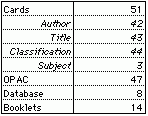
Booklets were produced by institutions with a certain amount of materials or with special collections, but others catalogued materials of the Islamic area together with Western language materials in the library catalogue.
Probably due to many institutions transliterating the materials in original language to romanizing, OPAC was being installed by numerous institutions. (transliteration system was rather used to input the data with other materials for OPAC.)
H. Access of Collected Materials
Of those institutions which replied "yes" as to holding original language materials, our survey further asked whether the original language materials are accessible to outsiders.

Over 90% of the institutions allow visitors to access their materials, including those which responded that their materials are "open to public with restrictions". The main reasons for those institutions which replied "closed to public", were either the collection was not arranged at all, catalogued, or due to materials being located in other departments.
H'. User Services (multiple answers if applicable)
Then the survey inquired what services are being provided for visitors to those institutions, which replied that their collections are "open to the public" or "open to the public with restrictions".

Reading privileges and photocopying services are most prevalent in the framework of general use. Reference is not provided by many institutions and requires users to search and specify the needed materials. Those institutions which specified "others", in this case is dealt in the same manner as other materials.
I. Concerning Original Language Materials of the Islamic Area
Concerning the original language materials of the Islamic area, other than the condition of the collections as well as arrangement methods, we further asked for comments at will in a specific column; which 40 institutions responded with numerous valuable opinions. The collated results are the following.
Collecting materials
Various institutions replied as to "acquisitions are entrusted to the teaching staff", "selections are entrusted to the bookstore", "only the donated materials will increase", while others have collected in original countries of publication, and some institutions acknowledged that it has reached the proper time on the sole purpose of enlarging its holdings to build a respectable collection.
Cataloguing
Most of the libraries do not have library staff specialized in Islamic area studies, thus they are dependent on teaching staff and part-time personnel for arrangement of materials. Furthermore, they lack proper and reliable guidelines which can be used as manuals. These are some of the problems institutions are currently encountering. There are institutions which "invited librarians as researchers from corresponding the Islamic area".
Computerization, Database compilation
It's been said that "treatment of Arabic characters and other special languages on the computer is difficult, while the NACSIS or to register them on the OPAC used on campus requires proper transliteration. Still, even for such transliteration, the method is not uniformly standardized, and some voiced their opinion as to have the NACSIS develop a standardized method of transliteration.
There are institutions which devised a database on the image from a card catalogue of the original language.
Search, Use and Reference
Even at institutions with large collections, search methods for
materials are not properly and fully developed. Some others replied
that "since the library stacks are open to the users, there is no
problem in searching and retrieving materials".
Three institutions responded that the "facility was seldom used", which were those with small collections. Those institutions with large catalogued collections, and with related departments and lecture courses, should later be surveyed on the conditions of the materials used.
Even when catalogues are compiled with the assistance of teaching staff, "library staff lack proper background knowledge of the content of the materials making reference difficult", such circumstance makes request from distant locations difficult for use, as seen in some institutions.
Mutual Cooperation
We received comments from institutions with small collections and those encountering difficulties in acquiring library staffs, on the "necessity to develop an online database system from one key institute" further to be "linked up with other institutes, and for the specialized experts to take a leadership role to standardize the arrangement and cataloguing methods of original language materials to ease the process of catalogue compilation".
From the institutions with large collections and having specialized staff standing-by, we received such opinions as "cataloguing should be standardized, necessity to exchange information to compile a bibliography, and to make general use possible."
The questionnaire further asked whether guidelines or seminars are necessary to clarify cataloguing procedure of the original language materials of the Islamic area.
a. Guidelines

b. Seminars

Overall, the demand for a guideline was high regardless of whether or not the institution had any collected materials, or in terms of the size of the collection. As for seminars, it would be safe to say that the majority of the institutions would think about this when the time arises.
Those institutions which replied the guidelines and seminars are "not necessary" were those with small or no holdings of materials related to Islamic studies.